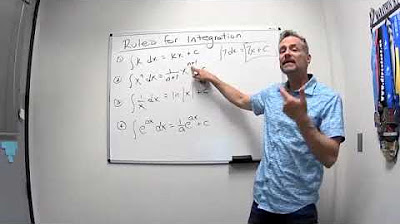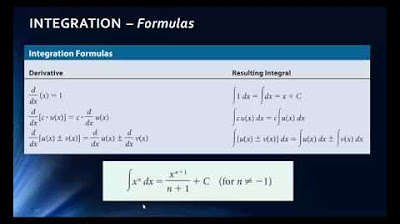BusCalc 13.1 Antiderivatives
TLDRThe transcript is a detailed explanation of anti-derivatives, which are mathematical functions that reverse the process of differentiation. The speaker introduces the concept by explaining that the antiderivative of a function is the inverse operation to taking the derivative. Using the integral sign, the antiderivative of a function can be found by applying various rules, such as the power rule, which involves adjusting the exponent of the function and multiplying by the new exponent. The importance of including a constant 'c' when finding an antiderivative is emphasized, as it accounts for the constant of integration. The transcript also covers the anti-derivatives of exponential functions, reciprocal functions, and the properties of additivity and homogeneity. Practical applications, such as modeling population growth and distance over time, are discussed to illustrate the real-world relevance of anti-derivatives. The speaker provides several examples to demonstrate how to calculate anti-derivatives for different types of functions and emphasizes the need to memorize key rules for solving problems involving anti-derivatives.
Takeaways
- 📚 The concept of anti-derivatives is introduced as the inverse operation to derivatives, where the antiderivative of a function is found by reversing the process of differentiation.
- 📝 The notation for anti-derivatives is represented by a tall squiggly symbol (\[ \int \]), which is read as 'the antiderivative of' when spoken aloud.
- ✍️ When finding the antiderivative, a constant (C) is always added to the end of the expression, as it represents an arbitrary constant that remains after differentiation.
- 🔢 The antiderivative power rule is the reverse of the power rule for derivatives, where you add one to the exponent and then divide by the new exponent.
- 🔁 The antiderivative of a sum of functions is the sum of the antiderivatives of each function, reflecting the additivity property.
- 🔄 The antiderivative of a constant times a function is the constant times the antiderivative of the function, showcasing the homogeneity property.
- 📈 The antiderivative of exponential functions (e^(kx)) is found by keeping the exponential term and multiplying by the reciprocal of the exponent.
- 📊 The antiderivative of the reciprocal function (1/x) is the natural logarithm of the absolute value of x, which is a special case due to the non-integer exponent.
- 🧮 The process of finding antiderivatives can be checked by differentiating the result and ensuring it matches the original function.
- 🏃♂️ In real-life scenarios, such as calculating the distance traveled by a runner, anti-derivatives are used to find quantities of interest from rates of change.
- 📊 For word problems involving growth rates, the antiderivative can be used to find cumulative quantities like population, given an initial value and a rate of change over time.
Q & A
What is the relationship between a derivative and an antiderivative?
-The antiderivative has an inverse relationship to the derivative. If a function f is the derivative of another function F, then F is considered the antiderivative of f.
What is the notation used for antiderivatives?
-The notation for antiderivatives is a tall little squiggle, sometimes called the integral sign or the antiderivative sign, represented as ∫.
How do you read the antiderivative notation out loud?
-You read the antiderivative notation out loud as 'the antiderivative of' followed by the expression inside the integral sign and ending with 'with respect to x' (or the relevant variable).
Why is a constant (usually denoted as 'c') always added to an antiderivative?
-A constant is added to an antiderivative because when you take the derivative of a function, constants disappear. Therefore, the antiderivative, which is the reverse process, must account for an arbitrary constant that could have been present in the original function.
What is the antiderivative of x^n according to the power rule?
-The antiderivative of x^n, where n is a constant, is (1/(n+1)) * x^(n+1) + c, where c is any constant.
How do you check if you have found the correct antiderivative?
-You can check if you have found the correct antiderivative by taking the derivative of your antiderivative and verifying that it equals the original function you started with.
What is the antiderivative of an exponential function e^(kx)?
-The antiderivative of e^(kx) with respect to x is (1/k) * e^(kx) + c, where k is any constant.
What is the antiderivative of the reciprocal function 1/x?
-The antiderivative of the reciprocal function 1/x is the natural logarithm of the absolute value of x, or ln|x| + c.
What are the properties of antiderivatives that are similar to the properties of derivatives?
-Antiderivatives share the properties of additivity and homogeneity with derivatives. This means that the antiderivative of a sum of functions is the sum of the antiderivatives of each function, and a constant factor can be taken out of the antiderivative.
How do you find the antiderivative of a function that is a sum of several terms?
-You can find the antiderivative of a sum of several terms by taking the antiderivative of each term separately and then adding them together, along with a constant c.
What is the antiderivative of a constant with respect to x?
-The antiderivative of a constant with respect to x is the constant times x plus c, as the antiderivative of a constant is the constant multiplied by the variable of integration.
Outlines
😀 Introduction to Anti-derivatives
The video begins with an introduction to anti-derivatives, explaining that they are the inverse of derivatives and have a relationship with integrals. The notation for anti-derivatives is discussed, along with the concept of the integrand and the constant 'c' that is added to the antiderivative. The importance of the constant 'c' is emphasized, as it can be any value and still yield the original derivative when applied.
📚 Anti-derivative Power Rule and Memorization
The video then delves into the anti-derivative power rule, which is the reverse of the derivative power rule. The presenter corrects a common mistake regarding the rule, emphasizing the importance of the 'n plus one' term in the denominator. The video also covers the anti-derivative of exponential functions and provides a method to check work by differentiating the antiderivative to confirm it matches the original function.
🔢 Anti-derivative Rules for Exponential and Reciprocal Functions
The presenter continues with examples of anti-derivatives for exponential functions and the reciprocal function. It is shown that the anti-derivative of a reciprocal function is the natural logarithm. The video also explains why the power rule for anti-derivatives does not apply when the exponent is negative one. The properties of additivity and homogeneity of anti-derivatives are introduced, which are similar to those of derivatives.
🧮 Applying Anti-derivative Rules to Specific Examples
The video script provides a series of examples where the anti-derivative rules are applied to various functions, including polynomials and exponentials. The process of applying the power rule, additivity rule, and homogeneity rule is demonstrated. The presenter also uses these examples to show how to find the antiderivative of a function and emphasizes the importance of including the constant 'c'.
🏃♂️ Anti-derivatives in Real-life Scenarios: Runner's Distance
The application of anti-derivatives is extended to real-life scenarios with a word problem involving a runner's velocity and distance. The concept that the derivative represents a rate of change, and the antiderivative undoes this to find the original property, is highlighted. The video concludes with solving for the time it takes for the runner to finish a race by using the derived distance function.
📈 Projected Population Growth Using Anti-derivatives
The video concludes with another real-life application, projecting the population growth of Midland, Texas. The growth rate function is given, and the antiderivative is taken to find the population function. The presenter shows how to find the constant 'c' in the antiderivative using a given data point and then uses the population function to estimate the population in a future year.
📚 Summary and Preview of Upcoming Material
In the final part of the video script, the presenter summarizes the key points covered in the lecture, emphasizing the importance of memorizing the anti-derivative rules. The presenter also teases the next topic, which will be integration by substitution, comparing it to the derivative chain rule but noting it is more complex.
Mindmap
Keywords
💡Anti-derivatives
💡Derivative
💡Integral Sign
💡Indefinite Integral
💡Power Rule
💡Exponential Function
💡Reciprocal Function
💡Additivity
💡Homogeneity
💡Real-life Application
Highlights
Chapter 13 focuses on finding anti-derivatives, which have an inverse relationship to derivatives.
If a function f is the derivative of F, then F is the antiderivative of f.
The notation for anti-derivatives is a tall squiggly symbol, often called the integral sign.
The antiderivative of 2x with respect to x is x squared plus c, illustrating the process of anti-differentiation.
The constant c in anti-derivatives can be any number, as it disappears when taking the derivative.
The antiderivative of x to the power n uses the reverse power rule, adding 1 to the exponent and dividing by the new exponent.
The antiderivative of an exponential function e to the kx is e to the kx times (1/k) plus c.
The antiderivative of the reciprocal function 1/x is the natural log of the absolute value of x plus c.
Anti-derivatives possess properties of additivity and homogeneity, similar to derivatives.
The anti-derivative power rule is crucial and frequently used, requiring memorization.
Examples are provided to illustrate the process of finding anti-derivatives for various functions.
The antiderivative of a constant times a function is the constant times the antiderivative of the function.
The concept of integrating by substitution is introduced as a method to be learned in the next class.
The importance of including the constant c in anti-derivatives is emphasized for accuracy in further calculations.
Real-life scenarios are used to demonstrate the application of anti-derivatives, such as calculating the distance a runner has traveled.
The antiderivative is used to find the projected population of Midland, Texas, given a growth rate model.
The value of c in a real-world problem can be determined by using known conditions, such as an initial population.
The antiderivative method is applied to find the function that gives the projected population at a future year.
Transcripts
5.0 / 5 (0 votes)
Thanks for rating:





